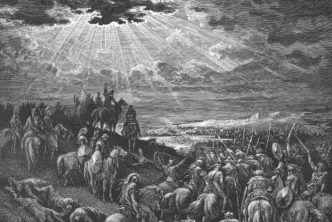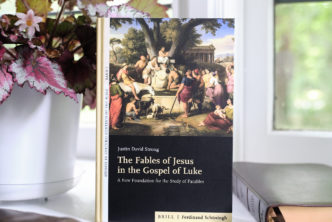A few weeks ago I saw Jurassic World, the latest installment of the Jurassic Park franchise based on the Michael Crichton novel by that name. The novel and the films center around the idea of bringing dinosaurs back from extinction by means of genetic engineering. It’s a fascinating premise, especially since some paleontologists and geneticists are working on real-world procedures for accomplishing the feat. If you want a glimpse of the real science, I recommend the book How to Build a Dinosaur, by paleontologist Jack Horner, the inspiration for Dr. Alan Grant, the paleontologist in Jurassic Park.
One of the more interesting background elements in Horner’s book is the story of Dr. Mary Schweitzer, who now teaches at North Carolina State University. When she began her journey into what would become her career, Schweitzer was a substitute teacher and mother of three. She gained Horner’s permission to audit his vertebrate paleontology class at Montana State. The rest is history. Schweitzer got hooked and soon became Horner’s protégé, earning a PhD in biology. She is now world-famous for discovering soft tissue in dinosaur bones that were 68 million years old. Young earth creationists thrilled to the discovery, touting it as incontrovertible proof that the earth is actually only thousands of years old, not millions since (they argue) soft tissue could never have survived that long.
There’s just one problem with this picture. Schweitzer is an evangelical Christian—and doesn’t agree with the young earth use of her research. By her own testimony, she learned that a lot of what she’d heard about her field and scientists in church wasn’t true. But the experience didn’t harm her faith; it made it stronger. Schweitzer is now an old-earth creationist. This is no secret in the paleontological community. Her faith is as well-known as her discovery. Schweitzer is living proof that serious Christians can be serious scientists.
Mary Schweitzer is also living proof that honesty and integrity in letting the Bible be what it is and doing science matter. She isn’t disputing the science behind the age of the bones she works on. She knows her field as well as anyone in the world. She isn’t pretending that we need a young earth to believe in the authority of Scripture. She understands that the Bible is an ancient work inspired by God not to give us science, but to give us truth about things that can’t be put under a microscope, like the spiritual world, our spiritual need, and our spiritual destiny if we believe God’s plan for salvation. Those truths transcend science and aren’t dependent on it. The Bible has a pre-scientific cosmology because God chose writers who lived in a pre-scientific age. He knew that would be no obstacle to communicating what he wanted communicated.
Schweitzer’s testimony is useful for framing another example of how the Bible gets interpreted out of context to address a modern controversy: the teaching that there are dinosaurs in the Bible. The alleged evidence comes in the form of words like Leviathan (לויתן, lwytn; e.g., Psa 104:26; Rahab (רהב, rhb; Isa 51:9); and “sea monster, dragon” (תנין, tnyn; Gen 1:21). This flawed notion isn’t as disastrous as the “Bible teaching” that arose to account for newly discovered races from the 16th century onward that produced “biblical” racism. No one is going to be enslaved or die because people believe it. Its harm is less discernible. It gets filed with other ideas that are falsifiable and, once Christians learn that it isn’t true, their faith in the Bible’s inspiration will be damaged when it doesn’t need to be.
How is this idea falsifiable? Context. As the Lexham Bible Dictionary (LBD) notes:
Leviathan is mentioned by name six times in the Hebrew Bible (Job 3:8; 41:1; Pss 74:14; 104:26; Isa 27:1). Most of these passages assert or allude to Yahweh’s power and control over the sea monster. The mythological background of the deity battling and defeating a sea monster (i.e., the Chaoskampf [“chaos struggle”] motif) is most evident in Psa 74:14 and Isa 27:1. . . . The mythological background of the Bible’s references to Leviathan became apparent with the discovery of Ugaritic references to a sea monster called “Litan” (ltn).
The Baal Cycle from Ugarit offers particularly precise parallels. LBD continues:
The Baal Epic recounts how the storm god Baal displaced El as the chief deity of the Canaanite pantheon. The story involves Baal defeating Yam, the sea god . . . . In this exchange, Mot refers to Baal’s defeat of Litan (or Leviathan), apparently equating Yam and Litan (KTU 1.5, col. i, lines 1–8). . . .
When you killed Litan, the Fleeing Serpent,
Annihilated the Twisty Serpent,
The Potentate with Seven Heads,
The heavens grew hot, they withered.
But let me tear you to pieces,
Let me eat flanks, innards, forearms.
Surely you will descend into Divine Mot’s throat,
Into the gullet of El’s Beloved, the Hero.The description of Litan in the first lines of this tablet from the Baal Epic use almost the exact words as the description of Leviathan in Isa 27:1.
Readers are invited to consult the LBD entries for “Rahab” and “Dragon and the Sea” for parallels an ancient texts from Ugarit and elsewhere to those biblical terms. The point I’m making here is that Leviathan and other “dinosaurs” are well-known mythological figures from uninspired texts outside the Bible contemporary with the biblical world. Pagan texts have their gods defeating these creatures to show their superiority or assert that their gods brought order over chaos at creation. But the Baal myth isn’t literally true. Baal didn’t really battle a dinosaur and become the god of all gods. These creatures are metaphors for the forces of chaos. Psalms 74:12–14 and 89:9–11 use this same metaphor to argue that it was Yahweh who subdued Leviathan / the sea dragon / Rahab to bring about creation order.[1. Note that Psalm 74:12–17 uses combat creation imagery to also describe God’s victory in the wilderness—i.e., the parting of the Red Sea and the conquest of Pharaoh.] The point of these passages isn’t that God was killing literal dinosaurs to transform the formless and empty world at creation. Rather, it was a polemic strategy to assert that Yahweh—not Baal or any other deity in the ancient world—was the lord of creation and Most High God. Interpreting these terms in their original context means we don’t have to fabricate “biblical meaning” to defend the Bible.
***
Agree? Disagree? Want to qualify? Sound off in the comments, like and share with your friends, and check by every Friday for more unfiltered insight from Dr. Michael Heiser.
Get the Lexham Bible Dictionary and an entire suite of digital Bible study tools designed by Dr. Heiser and the rest of Faithlife’s academic team with the Lexham Press Scholars Bundle.
***




God bless:
Interesting article. I liked very much your phrase “serious Christians can be serious scientists”. I would add: serious Christians can also be serious managers, serious entrepreneurs, and all kind of professionals.
I am not very knowledgeable about Earth’s age, etc. but I do have a problem with some findings.
If I am not mistaken, in Texas fossil dinosaur prints were found near hominid foot prints, and supposedly they walked in the area within 8 hours of each other.
Some less serious scientists supposedly tried to destroy the evidence, saying that that could not be there (what a shame).
Then you have Megalodon: the grandpa of white shark. According to secular scientists extinct 65 million years ago. Then someone found a tooth that was not fossilized, and then ungodly scientists change the date to extinct 2 million years ago.
Then deep sea cameras in Chile film one, and complete silence, not a word from the secular scientists.
Films of the Megalodon can be found in you tube, they have been found in different places, so 65 million? 2 million? they are alive!
It is very bothersome when conjectures are treated like laws and secular scientist want everyone to accept as law something that is not.
Blessings.
I live near Glen Rose State Park, and have been the the Creation Evidence Museum several times. I also have a degree in Nuclear Engineering, so I have some understanding of science.
What you say regarding the tracks is true. They’ve been much defaced over the years, but thankfully two prints are preserved in the museum and even the ones in the state park still look reasonably like human footprints. As a kid it was painfully obvious, which is why all the old timers that lived here back in the day take it as fact – it simply is.
I pretty much always find Dr. Heiser on point, so me learning that his arguments typically favor OEC surprised me. While I don’t disagree with what is here, it seems to me he – unnecessarily – takes up for OEC thinking that YEC has no evidence for it, when in fact it is the only reasonable theory to date via a plethora of evidence.
I haven’t seen him address the ‘days’ described in Genesis, but I’m pretty well informed with both sides of the equation and I’m a bit shocked at how he reconciles ancient earth with Genesis with other Biblical truths (ie no death prior to the Fall, etc).
Interesting comments in this article.
Lt me see, Paul says if Jesus Christ is not raised from the dead then …. I think he says if we discount the miracle of the resurrection we discount the Christian faith. Well, this article says there is spiritual truth and scientific truth. Let me see are you saying that the physical world has nothing to do with the Spiritual world?
One reason why many religions may have stories that are the same, is because there is historical fact imbedded in the religious traditions. Satan than tries to change the historical facts to suit his purpose. However, the spiritual in the death and resurrection of Christ is that Death is the result of Sin, the result of man’s rebellion against God in the Garden of Eden. If that is so, then death did not happen for millions of years before man came, since that cannot be the result of something that did not happen. If Death is not the result of sin, Christ’s death did not atone for our sin. Therefore we are still sinners, and the Christian faith is futile.
Let’s see…,
If you are a “serious Christian” and a “serious scientist” then you believe in an Old Earth.
If you believe in a Young Earth then you cannot be a “serious Christian” and a “serious scientist”!
Got it!
Well, that settles that.
Next.
Rick S.
Yeah, this is the only thing Dr Heiser has written that isn’t at all convincing, and actually is in direct contradiction to what he normally tried to do.
His aim is always to turn traditional beliefs on their head with what is actually going on, but here he concedes to YEC without really explaining why ‘days’ should not be interpreted literally, nor dealing with death before the Fall. To say nothing of the plethora of scientific evidence supporting the idea the world is young.
But maybe I don’t know science that well. It is a B.S. degree after all….
So the Bible has a similar story to the “false” religions of the area but because reasons the Bible story has some “true” meaning.